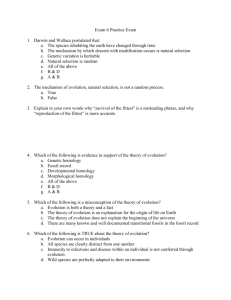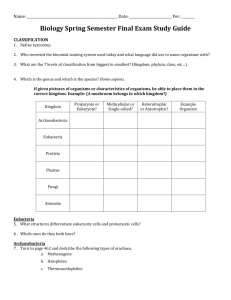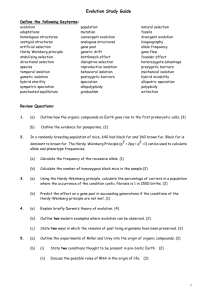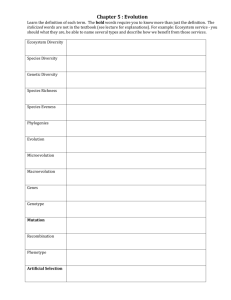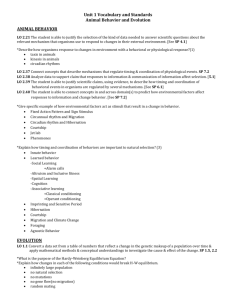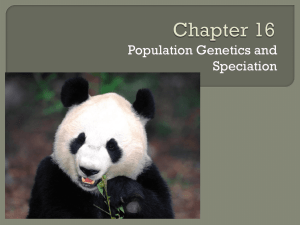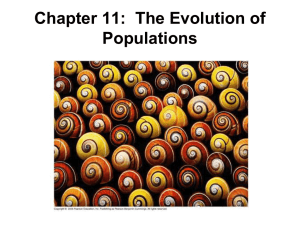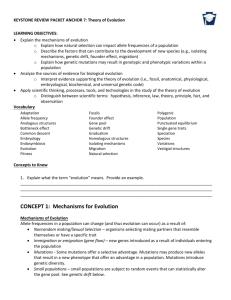Evolution Review - LFHS AP Biology
advertisement
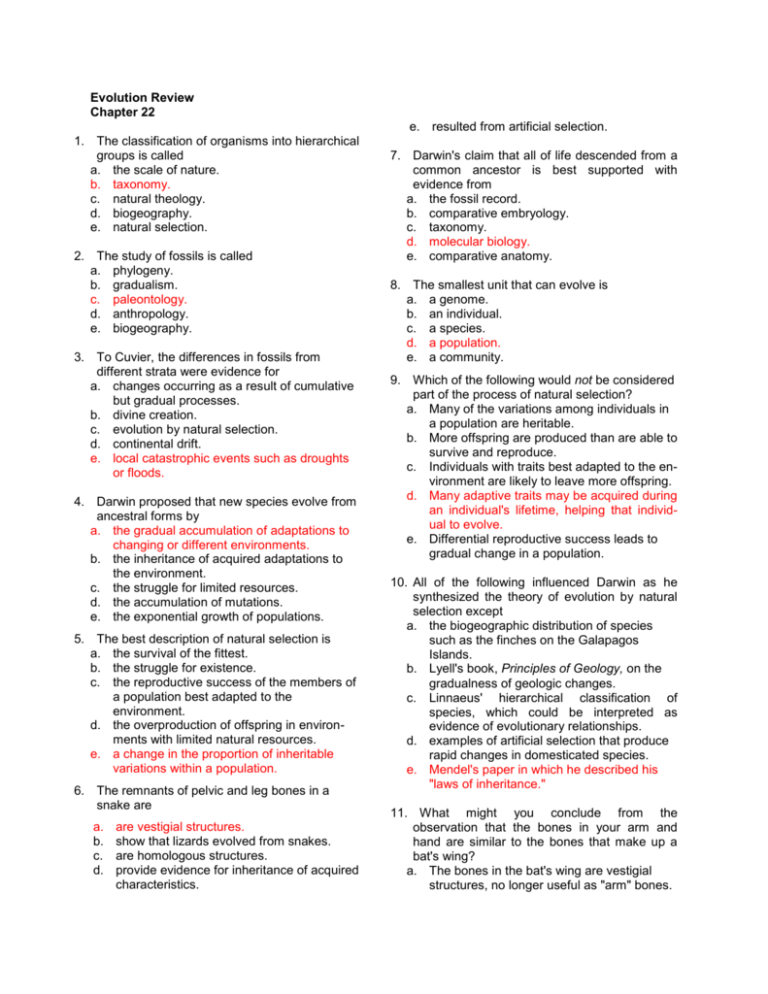
Evolution Review Chapter 22 e. resulted from artificial selection. 1. The classification of organisms into hierarchical groups is called a. the scale of nature. b. taxonomy. c. natural theology. d. biogeography. e. natural selection. 2. The study of fossils is called a. phylogeny. b. gradualism. c. paleontology. d. anthropology. e. biogeography. 3. To Cuvier, the differences in fossils from different strata were evidence for a. changes occurring as a result of cumulative but gradual processes. b. divine creation. c. evolution by natural selection. d. continental drift. e. local catastrophic events such as droughts or floods. 4. Darwin proposed that new species evolve from ancestral forms by a. the gradual accumulation of adaptations to changing or different environments. b. the inheritance of acquired adaptations to the environment. c. the struggle for limited resources. d. the accumulation of mutations. e. the exponential growth of populations. 5. The best description of natural selection is a. the survival of the fittest. b. the struggle for existence. c. the reproductive success of the members of a population best adapted to the environment. d. the overproduction of offspring in environments with limited natural resources. e. a change in the proportion of inheritable variations within a population. 6. The remnants of pelvic and leg bones in a snake are a. b. c. d. are vestigial structures. show that lizards evolved from snakes. are homologous structures. provide evidence for inheritance of acquired characteristics. 7. Darwin's claim that all of life descended from a common ancestor is best supported with evidence from a. the fossil record. b. comparative embryology. c. taxonomy. d. molecular biology. e. comparative anatomy. 8. The smallest unit that can evolve is a. a genome. b. an individual. c. a species. d. a population. e. a community. 9. Which of the following would not be considered part of the process of natural selection? a. Many of the variations among individuals in a population are heritable. b. More offspring are produced than are able to survive and reproduce. c. Individuals with traits best adapted to the environment are likely to leave more offspring. d. Many adaptive traits may be acquired during an individual's lifetime, helping that individual to evolve. e. Differential reproductive success leads to gradual change in a population. 10. All of the following influenced Darwin as he synthesized the theory of evolution by natural selection except a. the biogeographic distribution of species such as the finches on the Galapagos Islands. b. Lyell's book, Principles of Geology, on the gradualness of geologic changes. c. Linnaeus' hierarchical classification of species, which could be interpreted as evidence of evolutionary relationships. d. examples of artificial selection that produce rapid changes in domesticated species. e. Mendel's paper in which he described his "laws of inheritance." 11. What might you conclude from the observation that the bones in your arm and hand are similar to the bones that make up a bat's wing? a. The bones in the bat's wing are vestigial structures, no longer useful as "arm" bones. b. The bones in a bat's wing are homologous to your arm and hand bones. c. Bats and humans evolved in the same geographic area. d. Bats lost their opposable digits during the course of evolution. e. Our ancestors could fly. 12. Which of the following is an example of convergent evolution? a. remnants of pelvic girdles and limb bones found in whales b. two very different plants that are found in different habitats, but evolved from a fairly recent common ancestor c. similarities between the marsupial sugar glider and the eutherian flying squirrel d. the remodeling of a vertebrate forelimb in the evolution of a bird wing e. the many different bill sizes and shapes of finches on the Galapagos Islands CH. 23 1. Darwinian fitness is a measure of a. survival. b. number of matings. c. adaptation to the environment. d. successful competition for resources. e. number of viable offspring. 2. According to the Hardy-Weinberg theorem, a. the allele frequencies of a population should remain constant from one generation to the next if the population is large and there is no natural selection. b. only natural selection, resulting in unequal reproductive success, will cause evolution. c. the square root of the frequency of individuals showing the recessive trait will always equal the frequency of q. d. genetic drift, gene flow, and mutations are always maladaptive. e. all of the above are correct. 3. If a population has the following genotype frequencies, AA = 0.42, Aa = 0.46, and aa = 0.12, what are the allele frequencies? a. A = 0.42 a = 0.12 b. A = 0.6 a = 0.4 c. A = 0.65 a = 0.35 d. A = 0.76 a = 0.24 e. A = 0.88 a = 0.12 4. In a population with two alleles, Band b, the allele frequency of b is 0.4. What would be the frequency of heterozygotes if the population is in Hardy-Weinberg equilibrium? a. 0.16 b. 0.24 c. 0.48 d. 0.6 e. You cannot tell from this information. 5. In a population that is in Hardy-Weinberg equilibrium for two alleles, C and c, 16% of the population show a recessive trait. Assuming C is dominant to c, what percent show the dominant trait? a. 36% b. 48% c. 60% d. 84% e. 96% 6. Genetic drift is likely to be seen in a population a. that has a high migration rate. b. that has a low mutation rate. c. in which natural selection is occurring. d. that is very small. e. for which environmental conditions are changing. 7. Gene flow often results in a. populations that move to better environments. b. an increase in sampling error in the formation of the next generation. c. adaptive microevoluion. d. a decrease in allele frequencies. e. a reduction of the allele frequency differences between populations. 8. The existence of two distinct phenotypic forms in a species is known as a. geographic variation. b. stabilizing selection. c. heterozygote advantage. d. polymorphism. e. directional selection. 9. In a study of a population of field mice, you find that 48% of the mice have a coat color that indicates that they are heterozygous for a particular gene. What would be the frequency of the dominant allele in this population? a. 0.24 b. 0.48 c. 0.50 d. 0.60 e. You cannot estimate allele frequency from this information. 10. Sexual selection will a. select for traits that enhance an individual's chance of mating. b. increase the size of individuals. c. result in individuals better adapted to the environment. d. result in stabilizing selection. e. result in a relative fitness of more than 1. 11. A plant population is found in an area that is becoming more arid. The average surface area of leaves has been decreasing over the generations. This trend is an example of a. a cline. b. directional selection. c. disruptive selection. d. gene flow. e. genetic drift. 12. Genetic analysis of a large population of mink inhabiting an island in Michigan revealed an unusual number of loci where one allele was fixed. Which of the following is the most probable explanation for this genetic homogeneity? a. The population exhibited nonrandom mating, producing homozygous genotypes. b. The gene pool of this population never experienced mutation or gene flow. c. A very small number of mink may have colonized this island, and this founder effect and subsequent genetic drift could have fixed many alleles. d. Natural selection has selected for and fixed the best adapted alleles at these loci. e. The colonizing population may have had much more genetic diversity, but genetic drift in the last year or two may have fixed these alleles by chance. CH 24 Name the type of reproductive barrier and whether it is pre- or postzygotic for the following examples. Type of Barrier Pre- or Post- Example a.Hybrid sterility b.Post Two species of frogs are mated in the lab and produce viable, but sterile, offspring. c.Gametic isolation d.Pre Two species of sea urchins release gametes at the same time, but no cross fertilization occurs. e.Mechanical isolation f.Pre Two orchid species with different length nectar tubes are pollinated by different moths. g.Temporal isolation h.Pre Two species of mayflies emerge during different weeks in spring. i.Hybrid sterility j.Post Two species of salamanders will mate and produce offspring, but their offspring are sterile. k.Behavioral isolation 1.pre Two similar species of birds have different mating rituals. m.Hybrid inviability n.Post Embryos of two species of mice bred in the lab usually abort. o.Habitat isolation p.Pre Peepers breed in woodland ponds; leopard frogs breed in swamps. 1. A horse (2n = 64) and a donkey (2n = 62) can mate and produce a mule. How many chromosomes would there be in a mule's cells? a. 31 b. 62 c. 63 d. 64 e. 126 2. What prevents horses and donkeys from hybridizing to form a new species? a. reduced hybrid fertility b. reduced hybrid viability c. mechanical isolation d. gametic isolation e. behavioral isolation 3. Allopatric speciation is more likely to occur when an isolated population a. is large and thus has more genetic variation. b. is reintroduced to its original homeland. c. is exposed to different selection pressures in its new habitat. d. inhabits an island close to its parent species' mainland. e. All of the above contribute to allopatric speciation. 4. There are 28 morphologically diverse species of a group of sunflowers called silverswords found on the Hawaiian Archipelago. These species are an example of a. a geographical cline. b. adaptive radiation. c. allopolyploidy. d. the bottleneck effect. a. sympatric speciation. 5. Which of the following is descriptive of the punctuated equilibrium model? a. Long periods of stasis are punctuated by speciation and episodes of relatively rapid change. b. Microevolution is the driving force of speciation. c. Most rapid speciation events involve polyploidy in plants. d. Evolution occurs gradually as the environment gradually changes. e. In the framework of geologic time periods, speciation events occur very slowly and the equilibrium of species is punctuated by frequent extinctions. 6. Which of the following would not contribute to allopatric speciation? a. geographic separation b. genetic drift c. gene flow d. different selection pressures e. founder effect Chapter 25-26 Place the taxa (outgroup, A, B, C, and D) on the cladogram based on the presence or absence of the characters 1-4 as shown in this table. Indicate before each branch point which shared derived character evolved in the ancestor of that clade. Taxa Characters Outgroup O A B C D 1 0 1 1 1 1 2 0 0 1 0 1 3 0 1 1 0 1 0 0 0 0 4 1. The richest source of fossils is found a. in coal and peat moss. b. along gorges. c. within sedimentary rock strata. d. encased in volcanic rocks. e. in amber. 2. Which of the following is least likely to leave a fossil? a. a soft-bodied land organism such as a slug b. a marine organism with a shell such as a mussel c. a vascular plant embedded in layers of mud d. a freshwater snake e. a human 3. The half-life of carbon-14 is 5,730 years. A fossil that is 22,920 years old would have what amount of the normal proportion of C-14 to C12? a. ½ c. 1/6 e. 1/16 b. ¼ d.1/8 1 4. Related families are grouped into the next highest taxon called a a. class. b. order. c. phylum. d. genus. e. kingdom. 5. Convergent evolution may result a. when older structures are co-opted for new functions. b. when homologous structures are adapted for different functions. c. from adaptive radiation. d. when species are widely separated geographically. e. when species have similar ecological roles. 6. A taxon such as the class Reptilia, which does not include its relatives, the birds, is a. really an order. b. a clade. c. monophyletic. d. Not monophyletic 7. A biologist is studying the evolution of four similar species of birds. Which approach would allow her to choose the best phylogenetic tree from all possible phylogenies? a. Draw the simplest cladogram and choose that one. b. From a comparison of nucleotide sequences, determine the number of evolutionary events required for each tree and choose the most parsimonious tree. c. Compare the entire genomes of each species; the two most similar genomes are the two species that are most closely related. d. Determine which species can interbreed; those that can evolved from a common ancestor most recently. e. Choose the tree that has the most evolutionary changes required as the most probable explanation for why these similar birds have evolved into four distinct species. TRUE OR FALSE: Indicate T or F, and then correct the false statements. 1. A monophyletic taxon includes only species that share a common ancestor. T 2. The more the sequences of amino acids in homologous proteins vary, the more recently the two species have diverged. F Review topics from notes: Lamarck’s Principle of “felt needs,” use and disuse, and inheritance of acquired traits Cuvier and catastrophism, Lyell and uniformitarianism Darwin’s natural selection (differential reproductive success) 3 patterns of natural selection (stabilizing, directional, diversifying) Five conditions necessary for Hardy-Weinberg equilibrium (no nat. sel, no genetic drift, no gene flow, random mating, not mutations) Populations evolve (not individuals) Hardy-Weinberg problems Species definition Geographical isolation and adaptive radiation (contrast with convergent evolution) Convergent evolution and analogous structures Homologous structures, vestigial structures, analogous structures Types of prezygotic barriers (habitat, temporal, behavioral, mechanical, gametic) Types of postzygotic barriers (hybrid inviability, hybrid sterility) Sympatric speciation vs. allopatric speciation Binomial nomenclature, Heirarchy of 7 taxa (K,P,C,O,F,G,S), cladograms Atmosphere of early earth vs. today’s atmosphere Miller apparatus (started with H20, CH4, H2, and NH3 created amino acids, etc) 3. Phylogenetic trees determined on the basis of similar structures may be inaccurate when adaptive radiations have created large differences or when convergent evolution has created misleading analogies.T 4. A cladogram represents both the chronology and the age of evolutionary branches, as well as the degree of divergence between taxa. F 5. Phylogenetic trees designed with the concept of parsimony should show the most likely evolutionary relationships. T 6. Carbon-14 dating is not a good technique for sequencing fossils from the Carboniferous period (363290 mya) because carbon is too abundant in that period to allow accurate dating. F 7. The strongest support for a phylogenetic hypothesis comes from the concurrence of molecular and morphological evidence. T

